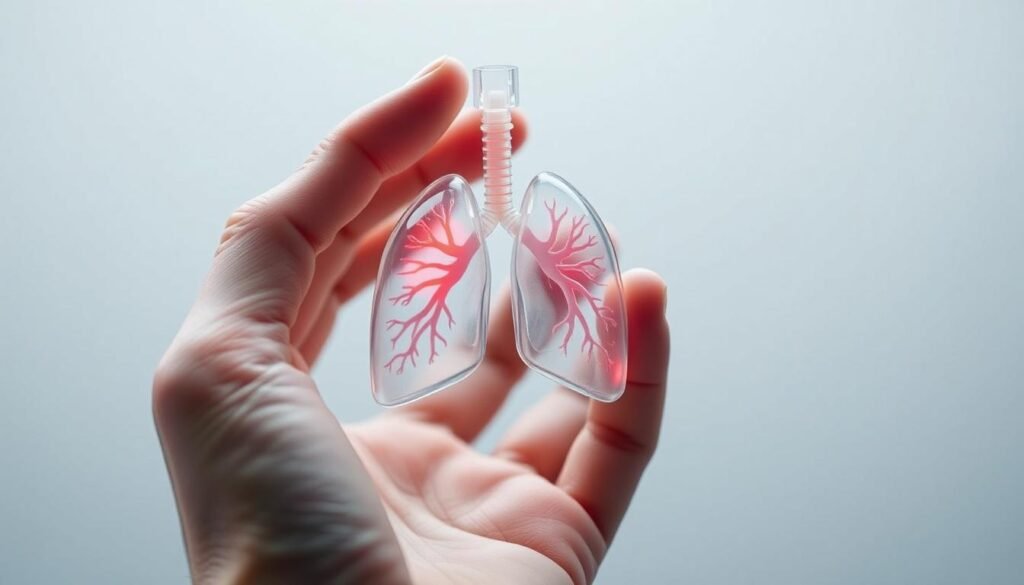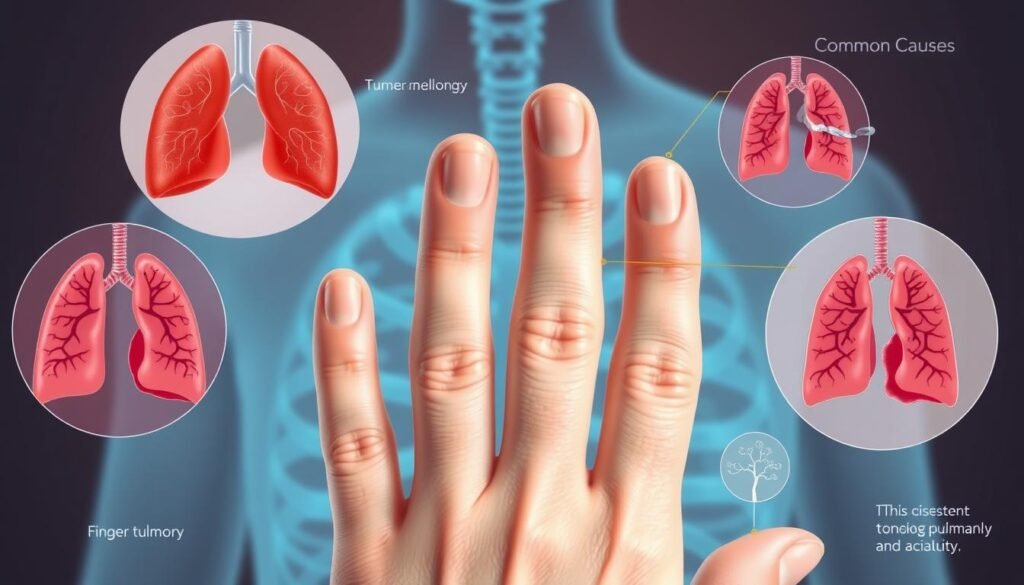Did you know that over 35% of people with non-small cell lung cancer (NSCLC) show signs of finger clubbing? This fact points out a key sign of possible lung cancer. It shows why the thumb test, especially the diamond finger test, is crucial for finding it early. Catching big problems early can mean more ways to treat them and better chances of survival.
The article explains how the thumb test is a simple, yet effective way to spot early signs of lung cancer, like finger clubbing. Knowing this link is key. It’s because finding cancer early can greatly improve how well treatments work and the patient’s prognosis.
Key Takeaways
- 35% of those with non-small cell lung cancer display finger clubbing.
- Finger clubbing can be a significant indicator, but it does not confirm lung cancer.
- Early detection is linked to increased treatment options and better outcomes.
- Awareness of symptoms like persistent cough and breathlessness is essential.
- Performing the diamond finger test can help in early screening efforts.
Introduction to the Thumb Test
The thumb test is a quick way to spot early signs of lung cancer. By observing finger clubbing, it helps people check their nail shape. You press nails of both thumbs together to see if a diamond-shaped gap forms. No gap may mean you should see a doctor. It’s key to know about the thumb test lung cancer early stage finger clubbing. Early detection is very important.
Changes in nail appearance could signal big health issues, like lung cancer. Around 30% of those with lung cancer show clubbing. If you smoke a lot or have lung issues, keep an eye on your nails.
Visit this source for more on nail clubbing. Spotting signs early is key to getting help fast. This can make a big difference in lung cancer care. For tips on early detection, check out this informative article.
Understanding Finger Clubbing
Finger clubbing changes the shape of fingers and nails, often due to severe health issues, including lung cancer. It is crucial for people to understand the finger clubbing lung cancer link. Early recognition of symptoms can lead to prompt medical check-ups.
What is Finger Clubbing?
Finger clubbing involves swelling at the fingertips and nails forming an unusual angle. It’s mainly linked with various health problems, especially lung cancer. About 80% of clubbing cases are secondary, meaning they result from other diseases. Remarkably, lung cancer accounts for approximately 90% of these cases, which highlights a significant finger clubbing lung cancer correlation.
Signs and Symptoms of Finger Clubbing
The development of finger clubbing happens in stages. Early on, finger clubbing symptoms might include nail base softening and skin redness. Later, fingertips might swell and nails could curve downwards. Patients may also have a cough, shortness of breath, and unexplained tiredness. Spotting these signs of finger clubbing early is critical for timely medical intervention, particularly with lung cancer.
Importance of Recognizing Finger Clubbing
Spotting finger clubbing early signs can help in diagnosing significant health issues quickly. Being alert to changes in nails or fingers is key. If someone notices these changes, they should see their doctor right away. Timely consultation may include tests like the thumb test lung cancer. These tests help identify any underlying conditions.
How the Thumb Test Works
The thumb test for lung cancer is easy to do yourself. It helps find possible lung problems. By knowing how to do it, you can look out for your health early on.
Performing the Diamond Finger Test
Anyone can try the diamond finger test at home. You just need to touch your thumbs or index fingers together with a bit of pressure. Seeing a diamond shape between your fingers means good circulation and lung health. If you don’t see the diamond, it might be a sign of something wrong, like finger clubbing. This could mean you need to check with a doctor.
What the Results Mean
Understanding your thumb test results is key. Not seeing the diamond shape doesn’t mean you have lung cancer right away. But it’s a hint that you should see a doctor. If you have these signs, getting help quickly can improve your chances of getting better. Early action is critical for managing your health better.
Thumb Test for Early Stage Lung Cancer Detection
The thumb test is an easy and effective way to spot early signs of lung cancer. It’s not meant to diagnose, but to urge people to get checked by a doctor if needed. It checks for finger clubbing, a symptom often linked to lung cancer.
Studies show that up to 35% of lung cancer patients have finger clubbing. This is mostly seen in those with non-small cell lung cancer, making up 87% of UK cases. Spotting this can push for earlier medical help, which can improve chances of recovery.
Right now, most lung cancer is found late, which makes it harder to treat. Three-quarters of the cases are caught in the late stages, raising the death rates from this disease. Using simple methods like the thumb test can make people more aware. It helps them talk to doctors early about lung cancer signs and risks.

To wrap up, the thumb test is a key tool in watching over our lung health. It helps catch lung cancer early, which can be crucial. Knowing about and using the thumb test can lead to taking action sooner for better health.
Correlation Between Finger Clubbing and Lung Cancer
Looking into how finger clubbing and lung cancer are connected means looking at the stats. There’s a clear link between them. This tells us how vital it is to know finger clubbing could be a warning sign.
Statistical Association
Studies show that 5% to 15% of lung cancer patients get finger clubbing. It’s a common sign. Around 80% of finger clubbing cases point to lung cancer. This fact underscores its symptom significance. Clubbing is more common in non-small cell lung cancer (35%) than in small cell (4%). Also, men are more likely to get it than women. This suggests who might be more at risk.
Comparisons with Other Health Conditions
But lung cancer isn’t the only condition linked to finger clubbing. It can also signal:
- Pulmonary fibrosis
- Other thoracic cancers causing chest tumors
- Cardiovascular disease
- Intestinal disease
- Liver disease
- Infections
So, finger clubbing could mean various health issues, not just lung cancer. It may go through stages, changing how nails and fingertips look. These changes can give doctors important hints.
| Condition | Prevalence of Finger Clubbing |
|---|---|
| Lung Cancer | 80% |
| Non-Small Cell Lung Cancer | 35% |
| Small Cell Lung Cancer | 4% |
| Hypertrophic Pulmonary Osteoarthropathy | 10-20% |
Keeping an eye on finger clubbing is key for spotting lung cancer early. If you notice changes, seeing a doctor right away is smart.
Common Causes of Finger Clubbing
Finger clubbing is a key sign of some health issues. It’s often linked with lung cancer causes, suggesting low oxygen from poor lung function. Spotting implications of finger clubbing helps find and treat these problems early.
Lung Cancer and Its Impact
Lung cancer is a top cause of finger clubbing. It can take years to develop but sometimes shows up quickly. As lung cancer grows, lung function drops, leading to less oxygen in blood.
Many lung cancer patients had stopped smoking before getting diagnosed. This shows there might be a connection between quitting smoking, lung health, and finger clubbing. Finger clubbing becomes more significant with chronic lung infections or toxins exposure.
Other Conditions Related to Finger Clubbing
Other issues like heart disease and Crohn’s disease are linked to finger clubbing, too. Conditions like hypertrophic pulmonary osteoarthropathy (HPOA) deepen the complexity of clubbing, requiring thorough health checks.
Some other causes of finger clubbing are:
- Thyroid disorders
- Cystic fibrosis
- Chronic lung infections
- Liver diseases
- Various cancers such as Hodgkin lymphoma
Knowing lung cancer’s related conditions aids in identifying why finger clubbing happens. A detailed check-up, including chest scans and lung tests, is vital for proper treatment.

| Condition | Related Symptoms | Diagnostic Tests |
|---|---|---|
| Lung Cancer | Reduced lung function, persistent cough | Chest CT scan, pulmonary function tests |
| Cystic Fibrosis | Frequent lung infections, digestive issues | Sweat test, genetic testing |
| Heart Diseases | Shortness of breath, fatigue | Echocardiogram, ECG |
| Thyroid Disorders | Fatigue, weight changes | Thyroid function tests |
| Gastrointestinal Disorders | Abdominal pain, weight loss | Endoscopy, colonoscopy |
Why Early Detection is Critical
Early detection of lung cancer is very important for patients. Knowing the stages of lung cancer is key to understanding why. At Stage 1, cancer is just in the lungs, which means treatment can work well. But as cancer grows, treatment options decrease, affecting how long people live.
The Stages of Lung Cancer
Lung cancer has different stages. Each one is different. Here’s a quick look at these stages:
| Stage | Description | Typical Treatment Options |
|---|---|---|
| Stage 1 | Localized cancer, small tumor | Surgery, radiation therapy |
| Stage 2 | Increased tumor size, possible lymph node involvement | Surgery, chemotherapy, radiation therapy |
| Stage 3 | Spread to nearby tissues or lymph nodes | Combination therapies, radiation |
| Stage 4 | Metastatic cancer affecting other organs | Palliative care, systemic therapies |
Benefits of Early Diagnosis
Finding lung cancer early makes a big difference. Early diagnosis leads to many benefits:
- More treatment choices
- Therapies work better
- People live longer
- Patients enjoy a better life
About 35% of people with a certain type of lung cancer show a specific symptom. Only 4% of another type show this sign. Finding cancer early can really help people live longer, better lives. Many studies prove this.
How to Consult a Doctor
Talking to a healthcare provider can be tough, especially with worrying symptoms. It’s key to know how to chat with your doctor for quick diagnosis and care. It’s crucial to talk about any symptoms to report to doctor, especially those linked to the lungs. Spotting signs of lung cancer early is vital, as lung cancer is a big concern for many.
Recognizing Symptoms to Report
You should talk to a doctor if you notice:
- Persistent cough that doesn’t disappear
- Unexplained tiredness or weakness
- Changes in how you breathe
- Clubbing of fingers, which signals serious issues
Bringing up these symptoms to report to doctor early increases the chance for successful early treatment.
Tests and Screenings for Lung Cancer
Doctors might recommend different lung cancer tests and screenings for lung cancer to find out if it’s cancer. These include:
| Test/Screening | Purpose |
|---|---|
| Chest X-ray | To see the lungs and spot problems |
| CT Scan | To get clear pictures of lung tissue |
| PET Scan | To find cancer cells and check activity |
| Biopsy | To examine lung tissue for cancer |
Talking about these tests, especially with symptoms like finger clubbing, helps with early care. For more on clubbed fingers and lung cancer, see this helpful article.
Preventative Measures and Lifestyle Changes
Knowing the lung cancer risk factors is key to prevention. Many people don’t realize how their lifestyle affects their health. This segment highlights risk factors and healthy habits that help lower cancer risk.
Risk Factors for Lung Cancer
Several things can make lung cancer more likely. Recognizing these lung cancer risk factors lets people choose wisely:
- Smoking: This is the top cause of lung cancer, responsible for many cases.
- Environmental Hazards: Long time exposure to radon, asbestos, and air pollution increases risks.
- Family History: Having relatives with lung cancer can raise your chances.
- Age: As people get older, especially after 65, lung cancer becomes more common.
Healthy Practices to Reduce Risk
Adopting healthy habits is crucial for preventing lung cancer. Here are changes that can lower cancer risk:
- Quit Smoking: Programs and support can help kick the habit.
- Balanced Diet: A diet full of fruits and veggies boosts health and the immune system.
- Regular Exercise: Staying active helps lung health and overall well-being.
- Avoiding Secondhand Smoke: Avoid places where smoking is common to lessen toxin exposure.
- Regular Health Checkups: Screenings can find issues early, leading to better treatment results.
Making these healthy changes not only lowers cancer risk. It leads to a healthier lifestyle all around. Every good choice improves lung health and enhances quality of life.
| Healthy Practice | Impact on Lung Health |
|---|---|
| Quitting Smoking | Significantly lowers the risk of lung cancer and benefits lung function. |
| Balanced Diet | Provides critical nutrients for immune health and cellular repair. |
| Regular Exercise | Boosts blood flow and oxygen distribution in the body. |
| Avoiding Pollutants | Lessens contact with substances that can harm lung tissue. |
| Regular Screenings | Finding health issues early can lead to quick action. |
What to Expect After Diagnosis
After finding out you have lung cancer, you will learn about different lung cancer treatment options. Knowing your options is key as you start your path to getting better. You might have surgery, chemotherapy, radiation therapy, or immunotherapy. Each one aims to control the cancer, keeping your health and wishes in mind.
Treatment Options Overview
It’s important for patients to look at all lung cancer treatment options. This includes clinical trials for new treatments. Choosing a treatment depends on the cancer stage, your health, and what you prefer. Here’s a quick look at common treatments:
| Treatment Type | Description | Typical Use Cases |
|---|---|---|
| Surgery | Removal of tumor and possibly surrounding tissue. | Early-stage cancer with no metastasis. |
| Chemotherapy | Use of drugs to kill cancer cells, often used after surgery. | Advanced cancer and in combination with other therapies. |
| Radiation Therapy | Utilizing high-energy rays to target tumors. | Localized treatment, pre- or post-surgery. |
| Immunotherapy | Boosting the immune system to fight cancer. | Particularly standard for non-small cell lung cancer. |
| Clinical Trials | Investigational studies for new therapies. | Patients seeking novel treatment strategies. |
Support Resources for Patients
Support is key after a lung cancer diagnosis. Many resources for lung cancer patients are out there to help. Support groups let patients share stories and connect. Counseling helps with emotional support, letting patients talk about their feelings and deal with them. Here are some helpful resources:
- American Lung Association – Offers educational materials and support resources.
- Lung Cancer Alliance – Provides online support groups and community resources.
- Cancer Support Community – Focuses on emotional support and wellness programs.
- Local hospitals and treatment centers – Often have patient navigators to guide through the process.
Getting diagnosed with lung cancer can be hard, but you don’t have to go through it alone. By looking into lung cancer patient support options, you can get the help you need during this tough time.

Personal Stories and Testimonials
Lung cancer stories show the tough road people walk after their diagnosis. Many share their battle with symptoms like finger clubbing, a clue to bigger health problems. Ruthra Coventry talked about her fight with recurring chest infections for years before finding out she had lung cancer. Her tale shows why it’s key to spot signs early, as it can really change the game.
Sue Reeves noticed she was losing weight and went to see a doctor. They found her lung cancer early, showing how vital it is to talk about symptoms with doctors. Stories about finger clubbing show that catching it early can improve chances, especially for a type of lung cancer where over 35% have this symptom.
Only 1% of UK folks know that a hoarse voice can mean lung cancer. This shows many don’t know about lung cancer signs. Sharing personal stories helps spread knowledge that can help others. In 2021, around 209,500 new lung cancer cases were recorded. They expect about 234,580 in 2024.
Hearing these stories raises awareness on symptoms and the importance of talking openly about health. These stories urge others to be alert and seek advice early. Finding cancer soon is crucial in the battle against it, as these real-life stories highlight.
| Patient Story | Symptoms Experienced | Diagnosis Outcome |
|---|---|---|
| Ruthra Coventry | Repeat chest infections | Lung cancer diagnosis after years |
| Sue Reeves | Weight loss | Early stage lung cancer diagnosed |
Conclusion
The thumb test is very important for finding lung cancer early. It helps spot finger clubbing, which can mean there are deeper health problems. For instance, finger clubbing is linked to serious conditions like lung cancer in about 80% of cases. So, it’s key to keep a close eye on your health.
Also, knowing what clubbing looks like is very helpful. Things like the loss of the hyponychial angle and abnormal finger depth are signs. If you see these signs, you should get medical help right away. Doing so can increase your chances of getting better. Regular checks and advanced tests like high-resolution CT scans are also vital.
For deeper insights on how finger clubbing relates to lung cancer, visit this resource. Being knowledgeable and active in caring for your lung health is important. It helps lower risks and improves your overall health.